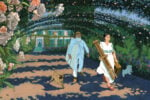Caroline Mesquita – Bal
.jpg)
Prima mostra personale in Italia dell’artista francese Caroline Mesquita.
Comunicato stampa
SpazioA ha il piacere di presentare sabato 23 maggio, 2015, alle ore 18, Bal, prima mostra personale in Italia dell’artista francese Caroline Mesquita.
Caroline mi ha dato appuntamento al Louvre per mettermi a parte delle opere che avrebbe presentato al Ballo organizzato a Pistoia.
Ci siamo incontrate sotto Lo scambio delle due principesse di Francia e di Spagna di Rubens. Ed è proprio qui che, inondate di luce divina, sotto una cornucopia che riversa gocce d’oro, perle e rose, mimeremo il gesto di accordo delle due principesse e giungeremo alla conclusione della scrittura di questo testo.
Il Ballo mette in scena una sorta di cerimonia fantasmatica.
I “corpi” di Caroline, ultimamente raffigurati nudi, in estasi o euforici, ritagliati in assenza di gravità nel metallo, o incisi al bulino come un messaggio d’amore o un insulto anonimo su una panchina pubblica, sono stati rivestiti per l’occasione di costumi molto più solenni.
Questi corpi, forse stanchi per le ore passate a ballare nel locale notturno di Camping, sembrano essere venuti a raccogliersi. Sono usciti dalla forma dei “pigri” animali che strisciano al suolo, per mettersi in piedi e drizzarsi verso il cielo. L’ottone ricoperto di foglia d’oro non imita più il corpo delle scimmie ma quello degli uomini.
Le donne non portano minigonne né tacchi alti per questa strana messa, ma vesti con corsetto e maniche a sbuffo ispirate allo stile del XVI secolo.
I capelli arruffati sono stati pettinati e acconciati con gioielli. I colli, cinti di gorgiere e nastri.
La figura maschile è accessoriata di elementi che evocano l’uomo di chiesa: mitra, ferula, casula e altri attributi religiosi.
Sulle vesti e gli abiti di ottone sono impressi, come marchiati da un ferro al calor bianco, i simboli della nobiltà e del potere: gigli, medaglie e altri segni riconoscibili di ricchezza presi a prestito per il Ballo dai pittori di corte, da Tiziano a Velazquez.
È in questa messa in scena teatrale e drammatica che interviene il barocco. Poiché a me sembra che, camuffata sotto i simboli dell’etica sociale, non sia l’incoronazione di una regina o di un re che viene celebrata, ma piuttosto la consacrazione di un amore. Grandioso e doloroso.
Immersi nel chiaroscuro, “spolverati” di una colonna sonora degna dei cartoni animati di Disney, i personaggi potrebbero essere sul punto di fare una riverenza, di allacciarsi e di danzare il valzer fino all’ultimo rintocco di mezzanotte, poiché la magia è là, sublimata.
Tuttavia, questi corpi vestiti a festa non hanno più braccia, e non si toccano che inavvertitamente. I preti, specie di simboli della buona coscienza, hanno corone che si staccano, pronte a frantumarsi a terra. I visi di ottone sono arrossiti di turbamento o di collera.
I loro cosmetici sembrano essere colati e aver sgocciolato sui loro abiti sontuosi, come in Morte a Venezia.
Respingono tutti quei marchi simboleggianti un ascendente che traduce il desiderio e le vestigia della passione. Li indossano, tatuati come una maledizione.
Lacrime di ossido macchiano le vesti “color di sole” delle belle principesse.
I motivi multicolori intervengono a involgarire, rendere isterico, umiliare. E se si sollevano quelle vesti, non mi sembra che le principesse di Caroline siano calzate di scarpette di vaio, e credo perfino di sentirle mormorare: «Amore, Amore non è affatto saggio! Amore, Amore mi ha reso folle!».
Lucile Littot
Caroline Mesquita (*1989, Brest, FR). Ha conseguito il Master of Fine Arts all’École des beaux-arts di Parigi e ha poi frequentato la Mountain School of Art di Los Angeles. Tra le mostre personali recenti segnaliamo: Sloths, Pavillon du Centre d’art du Parc Saint Léger, Pougues-les-Eaux, FR (2015); Windsurfers, Carlier Gebauer, Berlin DE (2015); Camping, Union Pacific, London, UK (2015); Les Bains-Douches, Les Bains-Douches, Alençon, FR (2014)
Le ultime mostre collettive a cui ha preso parte sono: Explore, FRAC Ile-de-France, Le Château de Rentilly, Bussy-Saint-Martin, FR (2014); Europe, Europe, a cura di Hans Ulrich Obrist, Gunnar B. Kvaran e Thomas Boutoux, The Astrup Fearnley Museet, Oslo, NO (2014); Possibles d’un Monde Fragmenté, a cura di Enrico Lunghi, Palais des Beaux-Arts, Paris, FR (2014); The Space Between Us, Flax Fondation, Fahrenheit, Los Angeles, US (2014); La Vie Matérielle, a cura di Yann Chateigné, 15ème Prix Fondation Ricard, Paris, FR (2013). L’artista vive e lavora a Parigi.
Caroline Mesquita
Bal
OPENING: MAY 23, 2015 - ore 18
TUE - SAT 11 - 14 / 15 - 19 OR BY APPOINTMENT
until 24.07.2015
Press release
SpazioA is proud to present on Saturday May 23, 2015, at 6pm, Bal, first solo show in Italy by French artist Caroline Mesquita.
Caroline arranged to meet me at the Louvre to look at the pieces she would be showing during Bal, organized in Pistoia.
We met up under Rubens’s Exchange of the Two Princesses of France and Spain. It was right there, flooded with divine light, beneath a cornucopia overflowing with drops of gold, mother-of-pearl pearls and roses, that we would imitate the gesture of agreement of the two princesses, and finish writing this text.
Bal presents a kind of fantasy ceremony.
Caroline’s “bodies”, latterly depicted naked, ecstatic and euphoric; cut out, in a weightless state, in metal, or engraved by burin like a love message or an anonymous insult written on a public bench, have been covered for the occasion by much more solemn costumes.
These bodies, perhaps tired by their hours spent dancing in the Camping nightclub, seem to have come to spend some moments in contemplation. They have left the animal form of the “idle” crawling over the ground, got to their feet, and reached for the sky. The brass covered with gold leaf no longer imitates the bodies of monkeys, but those of human beings.
The women do not wear miniskirts, or high heels, for this strange mass, but very full tight-waisted gowns inspired by the 16th century . Velvet capes trimmed with ermine on their shoulders.
Their tousled hair has been combed and dressed with jewels. Their necks in tight collars and ribbons.
The male figure is bedecked with items evoking the man of god: mitre, sceptre, chasuble and other religious trappings.
On the brass gowns and clothes are printed, as if branded with an iron, the symbols of nobility and power: fleurs-de-lis, medals and other recognizable signs of wealth borrowed for Bal from court painters, from Titian to Velazquez.
It is in this theatrical and dramatic presentation that the baroque comes into play.
For, camouflaged beneath these symbols of social ethics, it does not seem to me that this is the coronation of a queen or a king that we are celebrating here; rather, it is the coronation of a love. Grandiose and painful.
The characters plunged in this chiaroscuro light, “sprinkled” by a sound track, worthy of Walt Disney cartoons, might be ready to make a bow; to intertwine themselves and waltz until the last chime of midnight, because the magic is there, sublimated.
But, for all this, these bodies dressed to the nines no longer have arms and now only touch each other by mistake. The priests, as a sort of symbol of clear conscience, have crowns which become detached, ready to shatter on the ground. The faces have reddened with emotion or anger in the brass.
Their make-up seems to have run and dripped on their sumptuous clothes, like in Death in Venice.
They reject all these emblematic signs of power conveying desire and vestiges of passion. They wear them, tattooed like a curse.
Tears of oxide stain the “as bright as the sun” gowns of the lovely princesses. The multi-coloured motifs render things vulgar and hysterical, and have a humiliating effect. And if we lift up their gowns, it does not seem to me that Caroline’s princesses are wearing glass slippers, and I even think I can hear them whisper: «Love, love is not wise! Love, love has made me mad!».
Lucile Littot
Caroline Mesquita (*1989, Brest, FR). Received a Master of Fine Arts at the École des beaux-arts in Paris and after she studied at The Mountain School of Art in Los Angeles. Recent solo exhibitions include: Sloths, Pavillon du Centre d’art du Parc Saint Léger, Pougues-les-Eaux, FR (2015); Windsurfers, Carlier Gebauer, Berlin DE (2015); Camping, Union Pacific, London, UK (2015); Les Bains-Douches, Les Bains-Douches, Alençon, FR (2014)
Among the last group exhibitions she has taken part there are: Explore, FRAC Ile-de-France, Le Château de Rentilly, Bussy-Saint-Martin, FR (2014); Europe, Europe, curated by Hans Ulrich Obrist, Gunnar B. Kvaran and Thomas Boutoux, The Astrup Fearnley Museet, Oslo, NO (2014); Possibles d’un Monde Fragmenté,curated by Enrico Lunghi, Palais des Beaux-Arts, Paris, FR (2014); The Space Between Us, Flax Fondation, Fahrenheit, Los Angeles, US (2014); La Vie Matérielle, curated by Yann Chateigné, 15ème Prix Fondation Ricard, Paris, FR (2013). The artist lives and works in Paris (FR)



